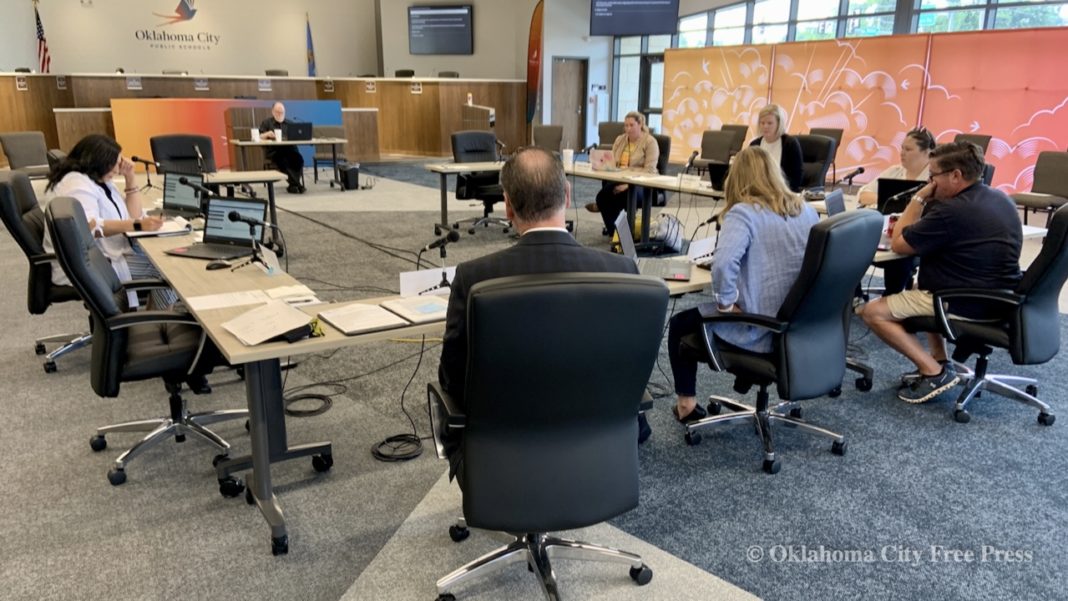Last Updated on July 20, 2021, 12:08 AM | Published: July 19, 2021
OKLAHOMA CITY (Free Press) — Although one of the shortest board meetings in some time, the Oklahoma City Public Schools Board of Education adopted two key procedural changes that will have a lasting impact on the business of the board.
One clarified what weight an abstention would have in a Board vote and the other was to set standards for how the district would move forward on the Decennial redistricting process for Board member election districts.
Redistricting
Once the U.S. Census Bureau establishes the new Census counts, OKCPS will need to go through a redistricting process just like other governmental entities.
It is not clear how redistricting happened in the district ten years ago after the last Census, but this Board decided on some particular principles that the Redistricting Committee – yet to be formed – will be expected to follow.
Key elements of the adopted resolution on redistricting were:
“If board member voting boundaries change because of census results, those changes will take into consideration:
• Districts with equal population
• Fair, equitable representation of all populations
• Compactness of a district”
Here’s how the newly-adopted policy structures the redistricting process:
- The Board will form a Redistricting Committee
- Each Board member will get to appoint one OKCPS constituent to the committee
- The Board Chair will appoint which Board members will be on the committee
- The Board Chair will choose the chair of the committee
- Superintendent McDaniel will appoint administration members to advise the committee
- The committee will solicit input from professional researchers and the community
The new policies are meant to show the public that there is a clear intent to move away from old Gerrymandering practices where districts at all levels of government were drawn with the intent to create a certain result other than representing all voters.
After the meeting, Board District 3 member Carrie Coppernoll Jacobs who chairs the Policy Committee talked with Free Press about proposals that came out of the Policy Committee which she chairs.
“So, … every school district, every city, everybody’s got to redistrict,” Jacobs told us. “And, we didn’t have a policy on it. And, I don’t think that there are many districts that do. And board policy is essentially a time for the board to say these are our values as a district.”
Jacobs said that in every redistricting effort there are outside interests that try to push the process to come out with a particular result. But, the Policy Committee wanted it to be known what the core standards would be once the process can move forward.
“It was a good conversation within the Policy Committee. And, I think what we’ve come up with are good goals,” said Jacobs.
Board Chair Paula Lewis weighed in on how important transparency of the process is to the public.
“If we’re gonna really run based on, you know, being a community board and a public board that does state dollars, regardless of whether kids are in our district or not, everybody’s state dollars comes to us [from] this area, and they need to see how we come to these decisions,” said Lewis.
“I think it allows us to be more of a team with the district,” Lewis told us. “It just leaves less room for people to be able to come in and think they can kind of pull off one board member … because we’ve all agreed this is where we’re moving.”
Abstentions
The adoption of a procedural clarification about how an abstention should count in a vote of the board was decided in an attempt to head off conflict in the future over the meaning of votes on the Board.
Previously, board policy was written in an unclear way where an abstention counted as a no vote because it still counted as a vote in the total and it was not a vote in favor.
In recent years abstaining from particular votes became more widely used especially by former Board member Charles Henry. The practice exposed the issue of whether someone could abstain and create a functional no vote, then later, deny voting against a measure.
Now, after Monday’s vote, an abstention does not count in the vote total. It is as if the one abstaining was not present.
Before the vote, recently-elected District 1 Board Member Carol Thompson argued for the idea of excluding abstentions from the count. She said that voters elect board members to come to board meetings and make decisions to vote for or against an idea, not abstain.
“The only reason for an abstention is if there is a conflict of interest,” said Thompson.
Jacobs agreed with Thompson’s comments made during the meeting and was glad the Board decided to clarify.
“There are either conflicts of interest, or there could be the appearance of impropriety, where you don’t want someone to say, well, that person just voted that way, because that’s their kid’s school,” Jacobs said.
“But, everybody should be voting the rest of the time, just like Carol said, but you need to be able to take yourself out and that not punish the motion,” she said.
Founder, publisher, and editor of Oklahoma City Free Press. Brett continues to contribute reports and photography to this site as he runs the business.










